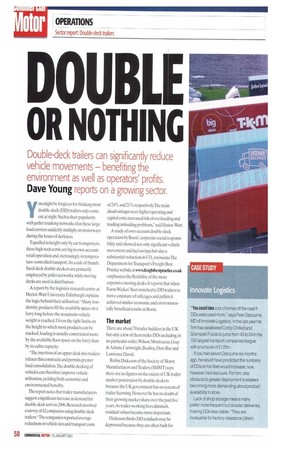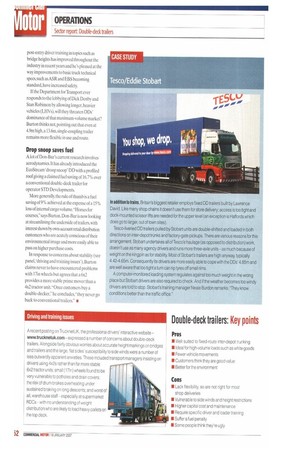DOUBLE OR NOTHING
Page 50

Page 51

Page 52

If you've noticed an error in this article please click here to report it so we can fix it.
Double-deck trailers can significantly reduce vehicle movements — benefiting the environment as well as operators' profits.
Dave Young reports on a growing sector.
you might be forgiven for thinking most double-deck (DD) trailers only come out at night. Such is their popularity with pallet trunking networks that these large load carriers suddenly multiply on motorways during the hours of darkness.
Equalled in height only by car transporters, these high-tech semis are big in own-account retail operation and, increasingly, in temperature-controlled transport. As a rule of thumb. fixed-deck double-deckers are primarily employed by pallet networks, while moving decks are used in distribution.
A report by the logistics research centre at Heriot-Watt University Edinburgh explains the logic behind their utilisation: "Many lowdensity products fill the available space on a lorry long before the maximum vehicle weight is reached. Given the tight limits on the height to which most products can be stacked, loading is usually constrained more by the available floor space on the lorry than by its cubic capacity.
"The insertion of an upper deck into trailers relaxes this constraint and permits greater load consolidation.The double decking of vehicles can therefore improve vehicle utilisation, yielding both economic and environmental benefits.
The report notes that trailer manufacturers suggest a significant increase in demand for double-deck units in 2006. Research involved a survey of 42 companies using double-deck trailers."The companies reported average reductions in vehicle-km and transport costs of 24% and 21% respectively.The main disadvantages were higher operating and capital costs,increased risk of overloading and loading/unloading problems," said Heriot-Watt.
A study of own-account double-deck operation by Boots' corporate social responsibility unit showed not only significant vehicle movement and fuel savings but also a substantial reduction in CO2 emissions.The Department for Transport's Freight Best Practice website at wrywireighthestpractice.co.uk emphasises the flexibility of the more expensive moving decks. It reports that when Focus Wickes' fleet switched to DD trailers to move a mixture of roll cages and pallets it achieved similar economic and environmentally beneficial results as Boots.
The market
'There are about 70 trailer builders in the UK but only a few of them make DDsincluding,in no particular order,Wilson, Montracon, Gray & Adams, Cartwright, Boalloy, Don-Bur and Lawrence David.
Robin Dickeson of the Society of Motor Manufacturers and Traders (SMMT) says there are no figures on the extent of UK trailer market penetration by double-deckers because the UK government has no system of trailer licensing. However he has no doubt of their growing market share over the past live years. As trailer working lives diminish, residual values become more important.
Dickeson thinks DD residuals may be depressed because they are often built for specific jobs and cannot (for height reasons) be sold into Eastern Europe where many conventional platforms go. R&M contracts are rare with trailers but he believes these might increase as complex DDs become more common, forming part of 'financial engineering' purchase packages.
Targeting the DD sector
Don-Bur has taken the strategic decision to target the complex, premium DD end of the semi-trailer market over the past few years, becoming market leader with an estimated 60% share.
"The DD sector has grown very quickly in the past five years," says David Burton, MD and son of the firm's lbunder,"although it has recently levelled off a little." Don-Bur's DD sales are split roughly 80/20 between lifting and fixed-deck respectively.They include temperature-controlled trailers—the firm claims to have been the first to produce one, for Sainsbury's — and curtain-sided multi-deck designs amounting to a current total of around 450 a year.
Burton attributes at least some of the increased operator interest to his firm's decision to"invest heavily" in DD demonstrators to take out to potential buyers and show the benefits of the concept. "All logistics companies are looking for an edge and the trailer plays an important part in this," he says.
Don-Bur also puts a great deal of effort into R&D, especially safety and aerodynamic features. In addition, it offers comprehensive aftermarket backing. With good maintenance and the TLC that DDs require (as a result of their complex engineering and hydraulics), trailers may last 10 or 12 years although many customers depreciate them over eight. Residual values. Burton claims, are very good — his firm also refurbishes and sells second-hand items— but, as he points out, many trailers are bespoke-built to suit particular jobs.
Don-Bur hosts an annual forum for up to 80 customers operating DD trailers to discuss issues and receive valuable feedback from the sharp end. "We work to customers' requirements regarding axle-loading and height — many regularly running into urban areas chose a height below the maximum limit [of 4.9m]," Burton explains.
Part of Don-Bur's customer service is a detailed handover procedure that ensures managers and drivers understand how the trailer works and thus employ it to optimum effect. "We never send a trailer without proper training," says Burton,"and sometime stay a week at customers premises." He believes post-entry driver training in topics such as bridge heights has improved throughout the industry in recent years and he's pleased at the way improvements to basic truck technical specs, such as ASR and EBS becoming standard, have increased safety.
If the Department for Transport ever responds to the lobbying of Dick Denby and Stan Robinson by allowing longer, heavier vehicles (LHVs). will they threaten DDs' dominance of that maximum-volume market? Burton thinks not, pointing out that even at 4.9m high, a 13.6m, single-coupling trailer remains more flexible in use and route.
Drop snoop saves fuel
A lot of Don-Bur's current research involves aerodynamics. It has already introduced the EcoStream 'droop snoop' DD with a profiled roof giving a claimed fuel saving of 16.7% over a conventional double-deck trailer for operator STD Developments.
More generally, the rule of thumb is a fuel saving of 9% achieved at the expense of a 15% loss of internal cargo volume. "Horses for courses," says Burton. Don-Bur is now looking at streamlining the underside of trailers, with interest shown by own-account retail distribution customers who are acutely conscious of their environmental image and more easily able to pass on higher purchase costs.
In response to concerns about stability (see panel,`driving and training issues'), Burton claims never to have encountered problems with 17in wheels but agrees that a 6x2 provides a more stable prime mover than a 4x2 tractor unit. "Once customers buy a double-decker," he concludes," they never go back to conventional trailers." a






















































































































































































